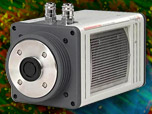Image Galleries
Featured Article
 Electron Multiplying Charge-Coupled Devices (EMCCDs)
Electron Multiplying Charge-Coupled Devices (EMCCDs)
By incorporating on-chip multiplication gain, the electron multiplying CCD achieves, in an all solid-state sensor, the single-photon detection sensitivity typical of intensified or electron-bombarded CCDs at much lower cost and without compromising the quantum efficiency and resolution characteristics of the conventional CCD structure.
Product Information
Interactive Java Tutorials
EMCCD Noise
The performance of electron multiplying CCDs depends on a number of interdependent factors. In addition to factors found in normal CCDs, such as quantum efficiency, full well capacity, dynamic range, dark current (and its related dark noise), and readout noise, additional factors are involved. Electron multiplication CCDs must be designed with consideration for additional gain related noise sources, multiplication of the dark noise along with the signal, gain ageing effects and the actual impact ionization phenomenon that produces the gain itself.
The operating temperature of a normal CCD will affect only the dark current value but in an electron multiplication CCD the temperature will also change the actual gain itself. The efficiency of the impact ionization process is inversely dependent on the CCD temperature. Lowering the CCD temperature will increase the gain efficiency and reduce the amount of voltage needed to produce the gain. This provides added benefits since the gain ageing is reduced by lowering the voltages used to produce a specific gain value. Lowering the CCD temperature will also reduce the dark noise which is multiplied at the same rate as the signal and this produces higher signal to noise ratios.
The optimum level of cooling would seem to be as low as possible but it is essential to factor in environmental conditions as well. Since very small changes in temperature affect both gain and dark noise, it is essential to cool the CCD to a temperature at which it can be guaranteed to be stable as ambient conditions change. For quantitative work, the temperature stability is as important as the temperature itself and the cooling system in the camera must have enough reserve cooling capacity to maintain the temperature over long periods in a changing environment. Most cooling systems can be operated at very low values but the stability at those temperatures may not be as good as at slightly higher values.






